
Gambia
British colony & protectorate
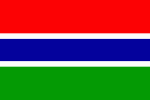
Gambia
Independent
Quick reference
General issues: British colony 1869-1901, British colony & protectorate 1901-1963, British colony & protectorate, self government 1963-1965, Independent within British Commonwealth 1965-1970, Republic 1970-2015, Islamic republic 2015-Present
Country name on general issues: Gambia, The Gambia
Currency: 1 (Gambia) Pound = 20 Shilling, 1 Shilling = 12 Pence 1869-1971, 1 Dalasy = 100 Bututs
Population: 90 400 in 1900, 1 925 000 in 2014
Political history Gambia
Gambia – since 1966 officially The Gambia – is located in western Africa. The population consists of Mandinka, who constitute the largest population group, and Fulbe and Wolof – Niger-Congo peoples living both in Gambia and other countries in western Africa. Several European countries have had trade settlements in Gambia – the Portuguese were the first to establish a settlement in the 15th century. The trade is, for over three centuries, mainly slave trade. In the 18th century, Gambia is contested by France and Great Britain. In the late 18th century, the French and the British sign a treaty by which the French acknowledge the rights of the British to Gambia. After the abolition of slavery by the British government in 1807, the British actively combat the slave trade. In 1816, Bathurst – the current Banjul – is founded as a trading post and a base to combat slavery, along with other forts at the mouth of the Gambia River. Throughout the 19th century, Gambia is administered from Sierra Leone for longer periods. From 1866 to 1888, Gambia is part of the British West Africa Settlements. In 1888, Gambia is ultimately established as a separate colony. An agreement on the borders is reached with the French in 1889 – the range of a cannon shot, 15 miles – on either side of the Gambia River. The British, being established effectively at Bathurst only, in 1894 declare the remainder of Gambia a British protectorate. The protectorate is brought under British control between 1894 and 1902. Other than in the colony, the British, in the protectorate, establish indirect rule through local chieftains. The colony and the protectorate are administratively integrated in 1901 as the colony – Bathurst and the direct vicinity – and protectorate of Gambia.
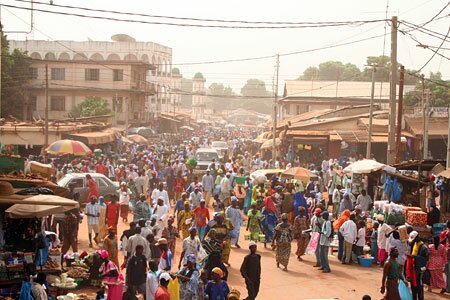
The market at Banjul
In the 1960’s, Gambia embarks on the road to independence. Self government is gained in 1963, independence within the British Commonwealth in 1965. In 1970, Gambia becomes a republic – still a member of the British Commonwealth. The membership was cancelled in 2013. Since 2015 Gambia is an islamic republic.
Since independence, Gambia has been ruled by Dawda Kairaba Jawara – first as prime minister and from 1970 as president. An attempted coup d’etat in 1981 was put down with the support of Senegalese forces. In the aftermath of the coup, Gambia and Senegal discussed a federation. Although treaties were signed in 1982, the federation only partly materialized and was dissolved in 1989. Dawda Kairaba Jawara was deposed through a coup d’etat in 1994 to be succeeded by Yahya Jammeh, who is still the president of Gambia. Subsistence agriculture employs most of the population in the Gambia economy, peanuts being the most important export product. In terms of per capita GDP Gambia ranks 210 out of 230 countries in the world.
Postal history Gambia
Mail from Gambia is known to be processed through Sierra Leone from 1853 – the stamps of Sierra Leone were valid for use in Gambia from 1861 to 1869. The first stamps for Gambia are issued in 1869. The issues, until 1886, show an embossed portrait of Queen Victoria. Later issues are of the common designs for the British possessions. In 1963, a set is overprinted to commemorate self government. Upon gaining independence, Gambia issues further overprints, now reading ‘Independence’ instead of ‘Self Government’. At the same time, a set of definitives is issued to commemorate independence. The stamps issued since the late 1970’s are almost exclusively aimed at the thematic collectors market.
Album pages
← Previous page: GabonNext page: German East Africa →

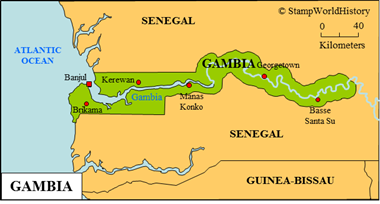
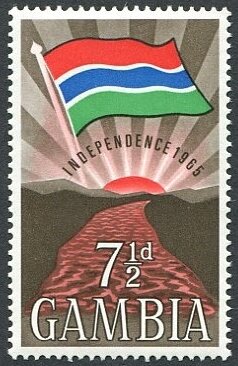

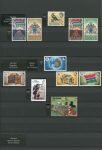
Hi,
Republic of The Gambia changed name to Islamic Republic of The Gambia in December 2015. Also, can you change “The membership will be cancelled in 2013.“ To „The membership was cancel in 2013.“ (Commonwealth membership)
http://www.bbc.com/news/world-africa-35359593
http://www.un.org/en/member-states/index.html#gotoG
And can you repair link to The Gambia map?
Best regards,
Admir
Admir
Thanks. I updated the profile. And added the islamic republic to my want list